
The Natural Georgia Series: The Fire Forest
Longleaf Pine-Wiregrass Ecosystem

 |
The Natural Georgia Series: The Fire ForestLongleaf Pine-Wiregrass Ecosystem |
 |
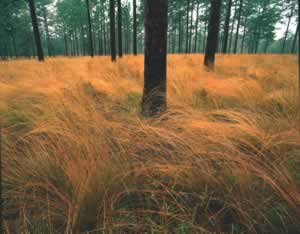 The
Natural History of the Fire Forest
The
Natural History of the Fire Forest
Like the phoenix of ancient mythology, the longleaf pine-grassland ecosystem rises reborn from its ashes. Longleaf pine woodlands are truly fire forests. While the drip torch has replaced lightning and Indians as the ignition source, these woodlands depend on frequent fire to maintain their biological richness and ecosystem health today, as they have for tens of thousands of years. In fact, longleaf pine savanna, which requires fire every one to three years, is one of the most fire dependent ecosystems in North America. The ever-present force of fire in this ecosystem molds tall, majestic pine trees with open crowns that seldom touch one another, so sunlight nurtures grasses and forbs in the ground cover into a parklike beauty. This open structure is strikingly different from that of the dense hardwood forests of the mountains and Piedmont or the lowland swamp forests. The range of names applied to the longleaf pine ecosystem-forest, savanna, woodland, or grassland with trees-captures some of the variation in structure in the communities that develop as a result of fire.
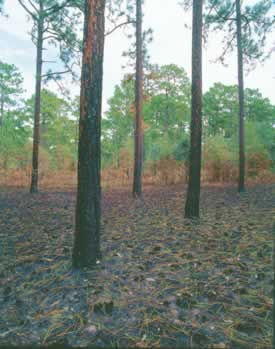 Fire's
Role
Fire's
RoleThis fire forest has played an important role in the cultural, biological, and economic history of the Southeast. Georgia's longleaf pine-wiregrass ecosystem was once part of the dominant vegetation type of the Coastal Plain of the southeastern United States. In less than 200 years, seemingly endless woodlands of majestic longleaf pine trees across the Coastal Plain (70-92 million acres) were reduced to a few small patches. Part of the story lies in the highly desirable characteristics of the longleaf pine. Large, straight, and tight-grained, the longleaf pine is the hardest pine in North America. Once railroad transport became available, vast acreages of timber were laid bare. Production of naval stores, such as turpentine, also played a role in the obliteration of the forests. Millions of trees were killed due to repeated tapping of the sap or to scorching when fire ignited the resin.
Land settlement further changed the face of the ecosystem. Conversion of forest for agriculture and spreading towns and cities took an obvious toll; other changes are subtler, but just as pervasive. Roads fragmented the forests, preventing fire from moving extensively across the landscape, with the result that some parts of the ecosystem burned less frequently. Periods of active fire suppression led to the near demise of a forest formerly shaped by fire. Today only ghostly vestiges, less than 3 percent of the original forest, remain to remind us of the enormity of the loss of our natural heritage.
Longleaf pine woodlands evolved in the lightning capital of the eastern United States. According to the U.S. Department of Agriculture, the Georgia/Florida Coastal Plain has the highest frequency of thunderstorms (averaging 70-90 days per year) of any region of North America. Lightning detection networks show not only how concentrated lightning strikes are in the Coastal Plain, but also their seasonality. The number of thunderstorms starts to increase in May and peaks in July and August. Lightning occurs when negative electrical charges that arise from friction of water molecules in the bottom of clouds discharge toward positive charges that collect on the ground, often selecting tall trees as conduits. The giant electrical spark heats adjacent air to as much as five times the temperature of the sun's surface, causing the air to expand rapidly and send sonic shock waves throughout the longleaf forest in the rumble of thunder.
Whether a lightning-struck longleaf pine tree ignites a blaze or not depends on several factors. One obvious factor is rainfall. In times of high relative humidity, or when grass and pine needle litter has been moistened by rain, the fuels often will not burn. A combination of drought and a storm that has more lightning than rainfall produces a greater chance for fire. One of the reasons fire frequently spreads in the longleaf pine ecosystem is the ease with which longleaf needles and native bunch grasses (primarily wiregrass) burn. Longleaf pines have the longest needles of all southern pines. As they fall, needles often rest loosely in the bunch grass crowns; circulating air keeps the fuel dry and creates conditions perfect for starting a burn. Longleaf pine needles are also full of resins that increase combustibility. Prior to European settlement, the Coastal Plain of Georgia was an extensive mosaic of longleaf-wiregrass woodland, and fire could burn for miles, uninterrupted except by wetlands along creeks and rivers that served to stop the progress of fire.
Lightning was not the only source of ignition for the fire forests. Native Americans were also promoters of fire. Pollen records show southern pines were present in the lower Coastal Plain about 20,000 years ago. While the Paleo-record for the Atlantic and Gulf Coastal Plain is not clear, it appears tremendous changes in vegetation occurred with the retreat of the Wisconsin glacier. In addition to climate change, the Southeast experienced dramatic changes in its population. Although the exact arrival time of the first settlers of the Southeast, the Paleo-Indians, is debated, certainly it coincided with the presence of pine-dominated forests. Native Americans were masterful in their use of fire. They understood that game would flock to recently burned areas, attracted to the tender, nutritious sprouts of regenerating grasses and forbs. They also burned to protect their dwellings, reducing fuels that could carry wild fire. Burning also cleared brush and briars, opening the woods to make traveling, agriculture, and hunting easier.
While there is little doubt that both lightning and indigenous populations were responsible for burning the pre-settlement Coastal Plain, the relative importance of each in molding the plant and animal community in longleaf systems is debated among ecologists and land managers. Some argue that plants evolved largely in response to lightning-ignited fires, and thus react differently to burning during the season that lightning fires are common (mid-May through August) than to burns in other times of the year. Supporting this argument is the strikingly abundant flowering response of wiregrass when it is burned in late spring and summer, and the near absence of flowering when burning occurs earlier in the year. This physiological response might be viewed as an adaptive strategy to produce seed only when the ground has been recently cleared of vegetation, increasing chances of establishment. Detracting from this theory is the fact that while fire may trigger some plant species to initiate flowering, most species in this ecosystem do not appear to be strongly dependent on a particular season of fire for successful reproduction.
Timing of fire and fire conditions play a critical role in the reduction of competing hardwood species in the longleaf pine ecosystem. Hardwoods are less tolerant of frequent fire than longleaf pines and are kept low or are killed with frequent fire. Infrequent fire allows hardwoods to dominate, shading out the diverse ground cover. When hardwoods are dormant, they are less likely to be negatively affected by fire; conversely, they are particularly damaged by fire shortly after they leaf out in the early spring. Fire application is increasingly sophisticated. Managers consider a variety of conditions that influence fire behavior, such as time since last burn, fuel moisture conditions, amount of fuels, and wind direction and speed to schedule controlled burns necessary for the rich biota of this ecosystem.
Certain physical features help plants survive and prosper in fire-dominated landscapes. Walking through the forests, visitors often bask in the beauty of trees and wildflowers, but they seldom consider the hidden half of plants-the roots. Structures below ground are critical to surviving fire. While fire consumes the above ground parts of plants, roots are unaffected. Energy, in the form of starch and sugar, and nutrition stored in large taproots provide the construction materials for new plants that sprout soon after fire. In fact, more than 90 percent of plants in longleaf-wiregrass systems are perennials, some with large tap roots and underground stems.
Fire also alters the way that nutrients flow in the ecosystem. Soils associated with the Coastal Plain tend to be droughty and low in nutrients. Plants that grow in relatively poor soils are often low in nitrogen. When leaves from plants drop, the nitrogen deficiency of the soil slows the rate at which microbes can decompose the dead plant material and release the nutrients contained within them. Fire releases many of the nutrients in a pulse of ash, but nitrogen, a vital forest nutrient, is largely lost to the atmosphere. To replace that nitrogen, native species of legumes (the bean family, Fabaceae) play a critical role. Legumes take nitrogen gas from the atmosphere (a form of nitrogen that is the most abundant in nature but unusable to most plants or animals) and transform it first into ammonia, and then into amino acids and proteins that can be used by plants. Some legumes appear to obtain up to 90 percent of their nitrogen from the atmosphere rather than from the soil. Numerous species of legumes occur in longleaf-wiregrass habitats, with estimates of more than 50,000 individual legumes per acre.
Plants and animals that make their home in this ecosystem not only survive fire but actually require fire for their existence; certain plants actually promote the frequent return of fire such as wiregrasses and longleaf pine needles that serve as fuel. Longleaf pine has an ingenious way of regenerating in areas with frequent fire. After germination, longleaf pine seedlings enter what is called the grass stage. During this time, longleaf pine seedlings do not grow in height but remain among the ground cover plants, appearing much like a clump of grass. While it takes approximately a year after germination to get to the grass stage, after that time seedlings are amazingly resilient to fire and can persist for 3 to 25 years in this grass-like clump. The long needles surrounding the bud are flammable, but they direct fire away from the bud. During this grass stage, the hidden half is busy growing. The taproot is growing deeper and larger to eventually help the longleaf surge to the sky. When seedlings are suitably developed (diameter of about 1 inch), they then rapidly grow in height, as much as 4 to 6 feet per year. This strategy allows for the growing bud to be exposed to high temperatures of fire for only a short period in its life cycle, permitting the longleaf sapling to survive fires that kill or inhibit the growth of many of its hardwood neighbors. Its fire resilience allows the longleaf pine to dominate the forest.
Successful regeneration usually occurs in tree canopy gaps where adult trees have died. Young pines are more likely to grow faster in open gaps than near an adult pine, because there is more sunlight and less competition for nutrients. Also, the pine needles that accumulate around mature trees fuel more intense fire that often eliminates the smaller and younger trees nearby. Acting together, competition and fire encourage regeneration in gaps in the forests situating new trees well away from established mature trees.
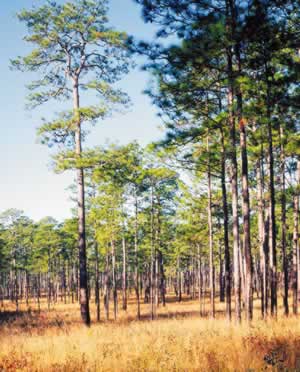 Longleaf
Pine's Environment
Longleaf
Pine's EnvironmentFire is unquestionably the major force sculpting the longleaf pine-wiregrass ecosystem, yet it is the interaction of fire with landform, soil types, and hydrologic regimes that produces the incredibly diverse natural gardens of the southeastern Coastal Plain. Longleaf pine-wiregrass is native to the Atlantic and Gulf Coastal Plains of Georgia, but the associated ground cover varies according to landform, soil type and hydrology. The subtle topography and arrangement of soils that have emerged over geologic time provide the backdrop upon which fire shapes a diverse assemblage of plant communities. It is the pattern of landscape features and an element of chance that dictate how fire spreads and how frequently it returns.
The pinelands of the Atlantic and Gulf Coastal Plains of Georgia occur on sedimentary depositions accumulated during times of marine submergence in the Cretaceous, Tertiary, and Quaternary periods (135 million to 11,000 years before present). Distinct physiographic regions occur within the Coastal Plain of Georgia as a result of erosion or burial during successive periods of submergence with rising and falling sea levels. Along the upper edge of the Piedmont Province, sediments weathered from the uplands were deposited near shore and formed what is known today as the sandhills, or Fall Line Hills, a narrow, hilly belt of deep sands. Most parent materials of the Lower Coastal Plain are marine deposits (sands, clays, thin fossiliferous layers of sands and clays). Along the eastern seaward portion of Georgia are poorly drained soils and nearly level topography or "flats" overlying a series of marine terraces that were associated with former shorelines of the Pleistocene Epoch (500,000 to 2 million years before present). Limestone deposition occurred across the state in conjunction with a fluctuating marine channel that once connected the Gulf of Mexico and the Atlantic Ocean until the early Miocene (25 million years before present). Sandwiched between impervious layers, a porous limestone formation formed the Floridian Aquifer that underlies a large portion of the Georgia Coastal Plain.
Coastal Plain soils in Georgia are extremely variable, ranging from excessively drained to poorly drained sites depending on landform, soil permeability, and soil texture (particle size). For example, deep sands are often associated with stream terraces and are exceptionally droughty soils. These highly permeable soils are leached of nutrients by rapid percolation of water. Poorly drained sites in upland sites, flats, or drainageways have thick surface or subsurface layers of clay that restrict water movement and sometimes create a perched or temporary water table. Intermediate drainage classes are usually found on gently rolling to level uplands. Seepage of slow-moving ground water occurs along bases of gentle slopes and creates acidic, nutrient-poor bogs. Sites with high soil moisture content or standing water for short periods generally burn less frequently than drier sites. Consequently, patterns of plant species distributions across a Coastal Plain landscape reflect the combined fire tolerance and moisture requirement of species.
Below the Fall Line, two geologic districts in southwestern Georgia are particularly noted for the longleaf pine-wiregrass uplands-the Dougherty Plain and the Tifton Uplands. The Dougherty Plain is characterized by outcrops of the Floridan Aquifer limestone that results in a karst topography, flat to gently rolling sandy soils with numerous sinkholes and associated ponds and marshes. Rising as much as 200 feet above the Dougherty Plain, the Pelham Escarpment delineates the Tifton Upland District, which occurs eastward to the Alapaha River.
"Drive-by" glimpses of the parklike longleaf pine forests of the Coastal Plain uplands suggest they are monotonously composed of two species, longleaf pine and wiregrass. However, closer inspection reveals that the ground cover carpet of wiregrass (primarily Aristida beyrichiana) is actually composed of a multitude of forbs, grasses, and low woody species. Particularly abundant are species in the grass (Poaceae), pea (Fabaceae), and aster (Asteraceae) families. Because of the rarity of the overall ecosystem today, many of the resident species are considered endangered or threatened because they are found only in these fire-maintained habitats. The numbers of plant species found in these communities are among the highest reported in North America, a fact little known and appreciated by most Georgians. Over 40 species can often be counted in a 10-foot square and well over 100 species may occur in a quarter of an acre. An extremely high number of species are endemic, or restricted to longleaf-wiregrass communities, and many of these species are now extremely rare. Undoubtedly, repeated but variable fire regimes in this system have contributed to the evolution of many species adapted to disturbance. Exactly why so many species are packed into this ecosystem, however, is likely to remain a mystery. The critically important questions are how to manage and sustain biodiversity of this ecosystem and how to restore the diverse biota to degraded sites.
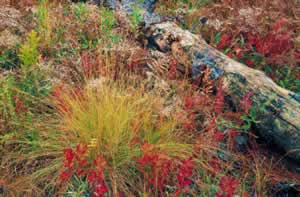 The
few remaining tracts of longleaf pine stands in Georgia are primarily associated
with private lands managed with fire for quail habitat or on military bases
where mission operations result in incendiary events. Most land that is suitable
for crop production has already been converted to agricultural uses. Some of
the largest tracts of longleaf pine-wiregrass remaining in the intermediate
moisture soils are located in southwestern Georgia, including a few virgin forest
stands. From these remnant forests and associated communities, the likely role
of natural fire regimes on vegetation across the landscape can be pieced together
by studying the results of prescribed fire practiced today.
The
few remaining tracts of longleaf pine stands in Georgia are primarily associated
with private lands managed with fire for quail habitat or on military bases
where mission operations result in incendiary events. Most land that is suitable
for crop production has already been converted to agricultural uses. Some of
the largest tracts of longleaf pine-wiregrass remaining in the intermediate
moisture soils are located in southwestern Georgia, including a few virgin forest
stands. From these remnant forests and associated communities, the likely role
of natural fire regimes on vegetation across the landscape can be pieced together
by studying the results of prescribed fire practiced today.
While the two dominant species-longleaf pine and wiregrass-remain prominent in frequently burned uplands with soils ranging from very moist to dry sandhills, variations in plant community composition are noticeable. In these upland sites, the number of species present increases as soil moisture increases. Such abundance of species results in particularly colorful floral displays in summer and fall. In addition, moist soils promote more rapid growth following fire than drier soils. Greater production of plant material means there is a greater amount of potential fuel to carry a fire. Fire return intervals of one to three years are necessary to maintain the openness of this community. Less frequent fire in these sites would result in the encroachment of more fire-intolerant hardwoods that eventually would shade out many of the herbaceous ground cover species.
At the other moisture extreme, the total number of species is fewer, with only the most drought-tolerant species present in the sandhills, although the total number of species is still exceptionally high when compared to most other plant communities in North America. As a consequence of decreased vegetative ground cover and pine needle litter production, sandhill sites are able to carry fire less often than more productive, wetter sites, even under prescribed fire regimes. The less frequent fire permits drought-tolerant scrubby oaks including turkey oak (Quercus laevis), sand post oak (Q. margaretta), or bluejack oak (Q. incana) to become established in a midstory.
Some plant communities, particularly embedded wetlands, are dependent on periodic occurrences of fire spreading from the surrounding longleaf pine landscape. Recurring upland fires will burn into the wetlands when conditions are dry. Fire perpetuates open vegetation conditions and a corridor of uninterrupted vegetation that connects uplands and wetlands. Some of the rarest species find their homes in these wet habitats, or in the ecotone, the zone between the upland and wetland communities. Seepage bogs provide examples of unique assemblages of species. These wetlands occur where groundwater slowly seeps out of a gently sloping bank due to underlying clay layers. Species occurring in these habitats are not only adapted to frequent fire but also to low nutrient and oxygen conditions due to inundated soils. Particularly interesting are the insectivorous species, such as trumpet pitcher plant (Sarracenia flava), hooded pitcher plant (S. minor), parrot pitcher plant (S. psittacina), several species of bladderwort (Utricularia spp.), sundews (Drosera spp.), and butterworts (Pinguicula lutea and P. carulea) that obtain nutrients from the insects they engulf. Many showy orchid species occur, including yellow-fringed orchid (Habenaria ciliaris), grass-pink (Calopogon tuberosus), and rose pogonia (Cleistes divaricata).
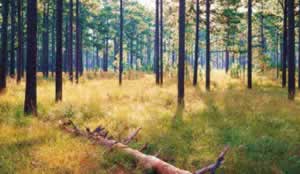 Wetlands
in limesink depressions in the southwestern part of the state and Carolina bay
depressions in the eastern portion are especially biotically rich habitats of
the longleaf-wiregrass ecosystem. These small to large depressions hold water
only periodically, and floristic differences among them result from variations
in moisture and fire conditions. A suite of "amphibious" plant species adapted
to persist after fire in flooded and dry conditions is found in these wetlands.
The wetlands and ecotone (border) between wetlands and uplands is noted for
many rare plant species, such as American chaffseed (Schwalbea americana),
canby dropwort (Oxypolis canbyi), awned meadow beauty (Rhexia aristosa),
and wild coco (Pteroglossapsis ecristata).
Wetlands
in limesink depressions in the southwestern part of the state and Carolina bay
depressions in the eastern portion are especially biotically rich habitats of
the longleaf-wiregrass ecosystem. These small to large depressions hold water
only periodically, and floristic differences among them result from variations
in moisture and fire conditions. A suite of "amphibious" plant species adapted
to persist after fire in flooded and dry conditions is found in these wetlands.
The wetlands and ecotone (border) between wetlands and uplands is noted for
many rare plant species, such as American chaffseed (Schwalbea americana),
canby dropwort (Oxypolis canbyi), awned meadow beauty (Rhexia aristosa),
and wild coco (Pteroglossapsis ecristata).
Just as the longleaf pine ecosystem is rich in species of plants, animal species are also abundant. Excluding species that merely migrate through the area, about 90 to 100 species of birds inhabit the entire ecosystem. Forty percent of these species are found year-round, 33 percent migrate from the Neotropics to breed, and 26 percent overwinter. The number of bird species that might be expected to occur regularly on a 20-acre plot of longleaf pine forest in the winter or the breeding season ranges from 5 to 20 species, depending on the quality of the forest. The bird species richness of one of the remaining old-growth longleaf pine forests is as high as that of any mature forest community in the Southeast. Approximately 36 species of mammals are typical of the longleaf pine ecosystem, over a third of which are rodents. Reptile and amphibian species (herpetiles) are unusually diverse in the longleaf pine ecosystem. Seventy-two species of herpetiles occur in the longleaf pine ecosystem, the largest group of which is the lizards and snakes with a total of 35 species.
The "innkeeper" animals of the longleaf pine ecosystem are some of its most unusual and ecologically important species. The habitations they build for themselves provide shelter and nest sites for many other species. Cavities made by the red-cockaded woodpeckers, for example, are as dynamic as busy hotels. Twenty-four other vertebrates have been documented to use red-cockaded woodpecker cavities, although some species, such as the wood duck (Aix sponsa), must have the cavities enlarged by other woodpecker species before they can be used. The complex burrow system of the pocket gopher (Geomys pinetis), with an array of shallow feeding tunnels connected by a "spiral staircase" to deeper food storage and nest chambers, hosts at least 80 species of arthropods-14 of which may be completely dependent on the pocket gopher. Many species of scarab beetles that are new to science have been discovered in pocket gopher burrows.
The most impressive innkeeper of the longleaf pine ecosystem is the gopher tortoise (Gopherus polyphemus). This large land turtle digs burrows roughly 15 feet long and 6 feet deep on average. Any feces deposited by the gopher tortoise in the burrow chamber are the food base for a large number of invertebrates. These invertebrates provide some food for frogs, lizards, and small mammals that also may forage above ground. Larger vertebrates, like indigo snakes (Drymarchon corais), may feed on some of the smaller animals and use the burrow for shelter. Over 300 invertebrates and 60 vertebrates have been documented to use gopher tortoise burrows!
A common misperception of fire in wild lands is that it turns all animals into crispy critters. For the vast majority of animals under typical fire conditions, this is not true. The slow and low fires that typify burning in the longleaf pine ecosystem do not kill many animals, but they do cause animals to change their behavior. Most animals simply move to get out of the path of the fire. Birds that forage mostly on the ground or in low vegetation will be temporarily displaced. Thousands of insects sense the oncoming fire and march up the trunks of trees to avoid fire, and these individuals readily re-colonize the site after the fire passes. As some larger insects try to move away from the fire, they are swept high into the air in the rising smoke column. Red-tailed hawks (Buteo jamaicensis) and American kestrels (Falco sparverius) are often attracted to fire to feast on "smoked" grasshoppers. Purple martins (Progne subis) are attracted to fire in the woods for the same reason. Many animals that are associated with longleaf pine-wiregrass habitats depend on the open habitat created by fire, and it is actually the lack of fire that does the most harm to these species.
Of the animals of the longleaf pine ecosystem, a high number, especially herpetiles, are of conservation concern. Eighteen percent of the amphibian species and a shocking 47 percent of the reptile species are threatened to some degree in states within the distribution of the longleaf pine. Only about 5 percent of the bird species and 14 percent of the mammals are considered to be of conservation concern, although additional species may be threatened within individual states.
Rare, old longleaf pine trees provide unique habitat for many animals, especially the red-cockaded woodpecker. As might be expected, habitat loss and fragmentation of the longleaf pine ecosystem are major threats to many species. Alterations of wetlands that are embedded in longleaf forests-caused by drainage, siltation from road runoff, and off-road vehicle use-negatively affect many amphibians during their breeding and larval periods. Condition of the transition area between these small isolated wetlands and the uplands is especially important. Stumps, stump holes, and fallen trees provide immensely valuable sites for many small mammals and herpetiles to live. Stumps from the oldest longleaf pine trees are commonly pulled from the ground and processed for resins, and very few snags and fallen trees are allowed to accumulate in any longleaf pine forest. Loss of native ground cover plant species from many areas has a negative effect on many arthropods that depend on the plants.
Public protection of this once dominant forest and recognition of its biological significance have been slow to develop in Georgia, but interest in its preservation seems to have grown recently. To restore and maintain the ecological integrity of the few remaining tracts, it is obvious that fire must be a part of the long-term plan. Clearly, challenges abound due to a lack of understanding of how to put the pieces of the puzzle back together. Specific knowledge of the life history of the plants and animals of the longleaf pine ecosystem is necessary, especially how they respond to fire management and the disturbances introduced by silvicultural or game species management. Some degraded longleaf forests desperately need restoration of fire and reintroduction of certain plant species in the ground cover that are well adapted to fire. Knowing that longleaf woodlands are the conduit of fire to other vegetation types makes preserving and reconnecting the ecotones between longleaf pine woodlands and associated habitats important. Only with patience and concerted effort for protection, restoration, and sound management will future generations of Georgians be able to marvel at the diversity of life in the longleaf pine "fire forest."
Read and add comments about this page
Go back to previous page. Go to Fire Forest contents page. Go to Sherpa Guides home.
[ Previous Topic | Next Topic ]